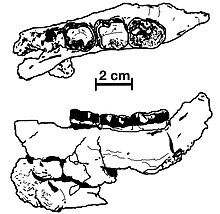
Back ناكاليبيثكس ناكاياماى ARZ Накалипитек Bulgarian Nakalipitec Catalan Nakalipithecus nakayamai CEB Nakalipithecus nakayamai Czech Nakalipithecus German Νακαλιπίθηκος Greek Nakalipithecus nakayamai Spanish Nakalipithecus nakayamai Basque میمون ناکالی Persian
| Nakalipithecus Temporal range: Tortonian,
| |
|---|---|

| |
| Top and side views of the Nakalipithecus holotype, a jawbone and the molars | |
| Scientific classification | |
| Domain: | Eukaryota |
| Kingdom: | Animalia |
| Phylum: | Chordata |
| Class: | Mammalia |
| Order: | Primates |
| Suborder: | Haplorhini |
| Infraorder: | Simiiformes |
| Superfamily: | Hominoidea |
| Family: | Hominidae |
| Genus: | †Nakalipithecus Kunimatsu et al., 2007 |
| Species: | †N. nakayamai
|
| Binomial name | |
| †Nakalipithecus nakayamai Kunimatsu et al., 2007
| |
Nakalipithecus nakayamai, sometimes referred to as the Nakali ape,[1] is an extinct species of great ape from Nakali, Kenya, from about 9.9–9.8 million years ago during the Late Miocene. It is known from a right jawbone with 3 molars and from 11 isolated teeth. The jawbone specimen is presumed female as the teeth are similar in size to those of female gorillas and orangutans. Compared to other great apes, the canines are short, the enamel is thin, and the molars are flatter. Nakalipithecus seems to have inhabited a sclerophyllous woodland environment.
- ^ Kiarie, Maina. "Nakalipithecus". Enzi Museum. Retrieved 8 August 2023.